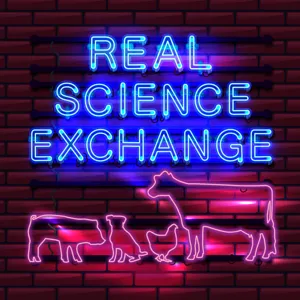Guests:
Dr. Chris Ashwell, North Carolina State University
Chandler Keck, Graduate Student, North Carolina State University
Tonight, we're going to switch it up a little bit and address some issues within the monogastric realm, but the ideas are ones that are generating a lot of interest across all segments of animal agriculture. And that topic is transgenerational inheritance.
Dr. Chris Ashwell discusses different research studies supplementing nutrients inside of the egg. He described a study that introduced a nutrient to the egg that ultimately had a negative influence on another trait. Trying to understand the equilibrium is always important. 10:30
Chandler Keck described his research and dissertation focusing on various stressors, mainly stocking density and feed restrictions, in poultry and how they affect each bird, as well as the transgenerational effects to the progeny of that bird. 13:45
The conversation then went on for Dr. Chris Ashwell to discuss clones of highly productive milking females in the dairy industry and how that relates to the poultry industry. The difference between species is, birds and reptiles have higher rates of new mutations, or variants in their sequences. The poultry industry is taking advantage of that by focusing on specific characteristics within superior individuals to change the heritability of these characteristics over time, instead of cloning. 20:00
Adding to the conversation, cohost Dr. Zack Lowman discussed a few research projects he worked on regarding early life feeding changes. Some producers are trying to get the birds as big as they can, as fast as they can, but their skeletal structures cannot support the weight at that early stage. He also discussed the research being done on sex ratios, and the statistical differences in poultry. 23:33
We continue with Dr. Chris Ashwell discussing the importance of more data for industry efficiencies and optimization of animal agriculture. But we also must be aware of how consumers are viewing our products in terms of animal welfare. We can grow a safe, efficient food supply, but must be cognizant of consumer concerns. 25:29
Both our guest experts discuss the financial impacts of restricted feeding and if the resources used on the individual bird will be amplified in the enormous population structure in a positive or negative way. 38:07
Closing out the conversation, Dr. Chris Ashwell discusses the idea of machine learning for big data. In machine learning you can analyze data you are currently focused on, while also seeing trends over time. Patterns might be discovered that are not being seen when focusing on certain values. 59:03
Don’t forget, if you want one of our new Real Science Exchange t-shirts, make sure to screenshot your rating, review or subscription, and email a picture to anh.marketing@balchem.com. Include your size and mailing address and we’ll get a shirt in the mail to you.
Please subscribe and share with your industry friends to bring more friends to join us around the Real Science Exchange virtual pub table.
This podcast is sponsored by Balchem Animal Nutrition and Health.


